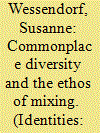| Srl | Item |
| 1 |
ID:
123189


|
|
|
|
|
| Publication |
2013.
|
| Summary/Abstract |
The London Borough of Hackney is one of the most diverse places in Britain. It is characterised by a multiplicity of ethnic minorities, different migration histories, religions, educational and economic backgrounds both among long-term residents and newcomers. This article describes attitudes towards diversity in such a 'super-diverse' context. It develops the notion of 'commonplace diversity', referring to cultural diversity being experienced as a normal part of social life. While many people mix across cultural differences in public and associational space, this is rarely translated into private relations. However, this is not perceived as a problem, as long as people adhere to a tacit 'ethos of mixing'. This comes to the fore in relation to groups who are blamed to 'not want to mix' in public and associational space. The article discusses the fine balance between acceptable and unacceptable social divisions in relation to specific groups who are seen to lead separate lives.
|
|
|
|
|
|
|
|
|
|
|
|
|
|
|
|
| 2 |
ID:
123186


|
|
|
|
|
| Publication |
2013.
|
| Summary/Abstract |
Three tower blocks and three low-rise blocks: nearly a hundred languages and over a hundred countries of origin. A council estate in a super-diverse neighbourhood is not only a space of concentrated difference and division, but also an intercultural space where new modes of living together emerge. At the same time, it is connected in an increasing number of ways with various outsides which make its internal space more complex. This article is based on a long-term collaborative research programme that included commissioned local policy research, academic ethnography and an artistic visual collaboration. It argues that multiple research strategies, including radically collaborative modes of inquiry, are required to represent the multiple, incommensurate perspectives co-present in the dense urban space of the estate.
|
|
|
|
|
|
|
|
|
|
|
|
|
|
|
|